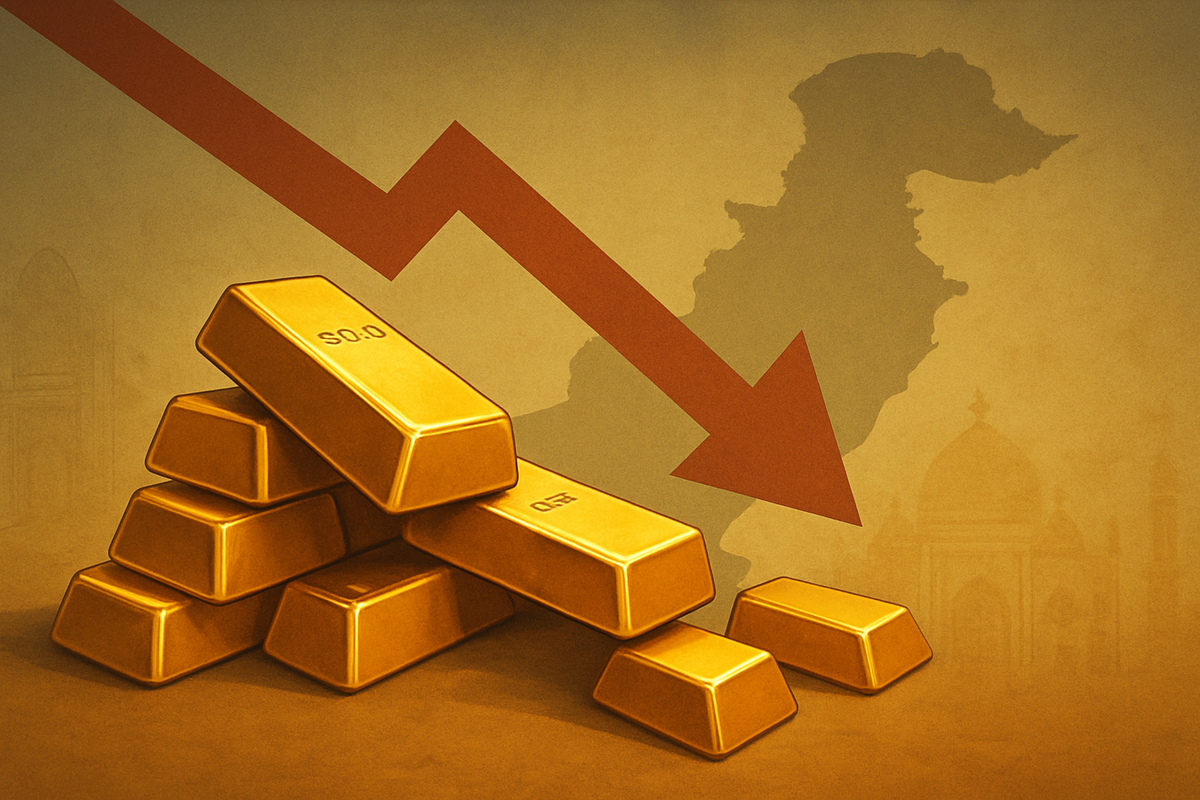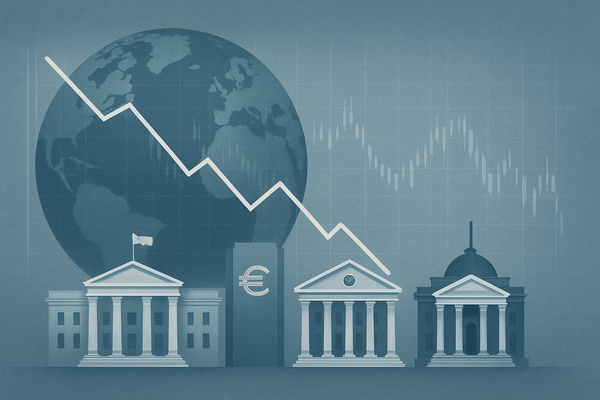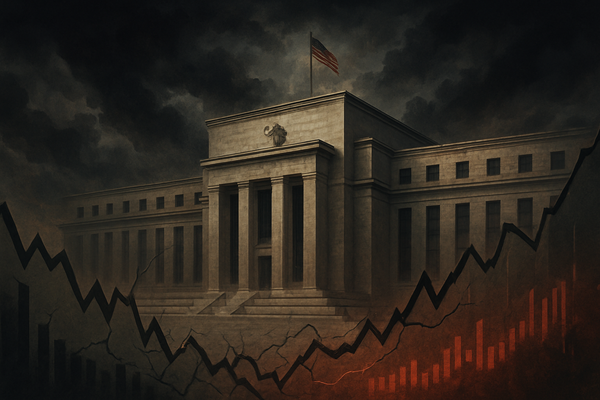Gold Market Tremors: Pakistan Sees Historic Plunge as Prices Shed Rs 14,000 Per Tola

Pakistan's gold market experienced a seismic shift on Tuesday, October 28, 2025, as the price of 24-karat gold plummeted by an unprecedented Rs 14,000 per tola. This dramatic single-day decline, bringing the price down to Rs 416,362 per tola, marked one of the steepest corrections in years and sent ripples of surprise through investors and consumers alike. The sharp downturn in local prices mirrored a substantial depreciation in the international bullion market, where spot gold traded near $3,909 an ounce, reflecting a decrease of approximately $88.3, or 2.21%, from the previous session. This significant event has immediate implications for Pakistan's economy, impacting everything from consumer purchasing power to the financial health of the jewelry sector and investment portfolios.
The sudden depreciation was driven by a confluence of global factors, including renewed optimism surrounding a potential trade deal between the United States and China, which dampened demand for gold as a safe-haven asset. A strengthening U.S. dollar further contributed to gold's decline by making it more expensive for holders of other currencies. Additionally, market participants were anticipating major central bank policy announcements, leading to cautious sentiment. The local market felt the full force of these global shifts, with 10 grams of 24-karat gold decreasing by Rs 12,003 to Rs 356,963, and silver prices following suit. This plunge follows a previous drop of Rs 3,300 per tola on Monday, October 27, 2025, and represents a correction of Rs 40,500 over just 11 days from an all-time high of Rs 456,900 per tola on October 17, 2025.
Unprecedented Downturn: A Deep Dive into Pakistan's Gold Market Correction
On October 28, 2025, Pakistan's gold market witnessed one of its most significant single-day drops in recent history. The price of 24-karat gold per tola in Pakistan plummeted by Rs 14,000, settling at Rs 416,362, a notable decrease from the previous trading day's closing price of Rs 430,362. This sharp decline was not isolated; internationally, gold prices tumbled by $140 per ounce, falling to $3,940 from $4,080, reaching a near three-week low. The impact was felt across the board, with 10 grams of 24-karat gold decreasing by Rs 12,003 to Rs 356,963, and 10 grams of 22-karat gold dropping by Rs 11,004 to Rs 327,227. Silver prices also declined, with per tola silver falling by Rs 173 to Rs 4,924.
This dramatic event is part of a broader, volatile trend in the Pakistani gold market. Just the day before, on October 27, gold prices had already fallen by Rs 3,300 per tola. The market had experienced a decline of around Rs 20,000 per tola since mid-October, indicating a significant correction after reaching an all-time high of Rs 456,900 per tola on October 17, 2025. This correction follows a period of robust growth throughout 2025, where gold prices had seen a cumulative increase of approximately 46.43 percent from January to October, with prices ranging between Rs 420,000 and Rs 470,000 per tola, peaking at Rs 470,000 in January due to soaring global demand and a depreciating Pakistani Rupee.
Key players and stakeholders in the Pakistani gold market include the All-Pakistan Gems and Jewellers Sarafa Association (APGJSA) or All Pakistan Sarafa Gems and Jewellers Association (APSGJA), which acts as the primary body for releasing daily gold and silver prices. The Karachi Sarafa Market serves as the national benchmark. International gold markets, such as COMEX and spot gold, heavily influence local prices due to import dependencies and currency parity. The State Bank of Pakistan (SBP), while not directly setting prices, indirectly influences rates through its exchange rate policies. Local dealers, jewelers, and investors are active participants, with jewelers involved in sales and manufacturing, and investors viewing gold as a safe-haven asset.
Initial reactions to the plunge have been mixed. Jewelers reported "sluggish buying activity" despite the ongoing wedding season, with many manufacturing units struggling due to weak consumer interest. Investors, particularly those who had anticipated continued surges, were rattled, with analysts advising close monitoring of currency movements. The public, however, might find some relief, as the price drop could make jewelry more accessible, although gold is still considered "out of reach for many people." The market is currently in a "wait-and-watch" sentiment, driven by global financial uncertainties and upcoming central bank decisions.
Corporate Currents: Winners and Losers in the Gold Price Volatility
The significant gold price plunge on October 28, 2025, has created a complex landscape of potential winners and losers among public companies in Pakistan, particularly within the financial and jewelry retail sectors. Gold's profound cultural and economic significance in Pakistan, serving as both an investment and a hedge against inflation and currency depreciation, means that market fluctuations have widespread effects.
In the financial sector, banks with substantial gold-backed loan portfolios could face challenges. A sharp drop in gold prices directly diminishes the value of the collateral held against these loans, potentially leading to increased loan-to-value (LTV) ratios. This might compel banks to demand additional collateral or increase provisions for potential non-performing loans, impacting their profitability. Conversely, financial institutions focused on other asset classes might indirectly benefit if the global factors causing gold's decline, such as a strengthening US dollar, lead to a more stable or appreciating Pakistani Rupee, easing pressure on import costs and inflation for businesses they finance. Brokers facilitating short-selling of gold, though less common for physical gold, could also see increased activity.
The jewelry retail sector is particularly vulnerable. Retailers and manufacturers hold significant inventories of gold, and a sudden price drop immediately devalues their existing stock, leading to inventory losses that can significantly impact their balance sheets and profitability. This comes at a time when jewelers have already faced reduced consumer demand due to previously high prices and inflation. However, in the short to medium term, the lower prices might stimulate consumer demand, especially ahead of wedding seasons, as buyers perceive an opportunity to purchase gold at more affordable rates. This potential surge in sales volume could help offset some inventory losses. Companies that had diversified into gold-plated or imitation jewelry due to high prices might face renewed competition but could also cater to a segment still seeking affordable options.
Beyond these direct sectors, other industries could also feel the ripple effects. Any publicly traded gold mining companies in Pakistan would experience a direct reduction in revenue and profitability, as the value of their reserves decreases, potentially impacting future projects and stock prices. The consumer goods sector could see mixed impacts; a stronger Rupee, if it results from the global trends driving gold prices down, might lower the cost of imported raw materials and finished goods, benefiting some companies. However, a perceived reduction in wealth among a population that traditionally invests in gold could dampen overall discretionary consumer spending. Investment banking and brokerage firms might also see a shift in investment patterns; if confidence in gold as a safe haven wanes, funds could be redirected towards other asset classes like equities, potentially boosting trading volumes in those areas.
Beyond the Bullion: Wider Implications and Market Dynamics
The gold price plunge in Pakistan on October 28, 2025, carries significant wider implications, resonating across global and local industry trends, sparking ripple effects throughout the economy, and potentially prompting regulatory considerations. This event underscores the profound interconnectedness of Pakistan's gold market with international dynamics and domestic economic realities.
Globally, the decline aligns with broader trends influenced by the strength of the US Dollar, which typically makes dollar-denominated gold more expensive and thus less attractive. Rising interest rates or the anticipation of them also tend to diminish gold's appeal compared to interest-bearing assets. Crucially, economic stability and easing geopolitical tensions, such as renewed optimism over a potential US-China trade deal, reduce the demand for gold as a safe-haven asset. Conversely, persistent inflation could, in the long run, reassert gold's role as a hedge. The policies of global central banks, particularly their gold reserve management, also play a pivotal role in shaping international supply and demand.
Locally, Pakistan's gold market is acutely sensitive to these international shifts, primarily because the country imports most of its gold. The exchange rate of the Pakistani Rupee (PKR) against the US Dollar is another critical determinant; a weaker rupee inflates local gold prices, while a stronger rupee can mitigate global increases. Local demand, often driven by cultural events like weddings, can also introduce unique dynamics.
The ripple effects within Pakistan's economy are substantial. The jewelry industry, already struggling with high prices and reduced consumer demand, faces a double-edged sword. While the price drop might stimulate some buying, particularly for wedding seasons, the devaluation of existing inventory leads to immediate losses for jewelers. For consumers and investors, the plunge offers an opportunity for those looking to buy but presents significant losses for those who purchased at higher prices. This volatility could foster cautious investor sentiment, with many adopting a "wait-and-see" approach. In the financial sector, a shift away from gold as a primary investment could redirect funds towards other asset classes.
From a regulatory standpoint, the State Bank of Pakistan (SBP) would be closely monitoring the situation. Its role in exchange rate management becomes even more critical, as a strong rupee can help stabilize local gold prices. The SBP's monetary policy decisions, particularly regarding interest rates, could also be influenced by the broader economic signals sent by gold market volatility. Furthermore, import/export policies related to gold might be reviewed to manage demand and stabilize the market. The All Pakistan Sarafa Gems and Jewellers Association (APSGJA), which sets benchmark prices, would need to ensure market transparency and potentially explore measures to protect consumers from extreme volatility.
Historically, Pakistan's gold market has mirrored its economic journey. Periods of currency devaluation and high inflation have consistently seen gold prices soar, as it serves as a reliable hedge. Global economic crises and geopolitical events have also historically driven up local gold prices. The current drop, while significant, is part of the market's inherent volatility, reflecting the interplay of global factors and local currency dynamics. For instance, the recent high of Rs 456,900 per tola on October 17, 2025, followed by this plunge, illustrates the rapid fluctuations characteristic of the market.
The Road Ahead: Navigating Gold's Future in Pakistan
Following the significant gold price plunge on October 28, 2025, Pakistan's gold market faces a dynamic and evolving future, presenting both challenges and opportunities for various stakeholders. The path forward will be heavily influenced by global economic indicators, domestic policies, and the inherent cultural significance of gold in Pakistan.
In the short term, gold prices are expected to remain volatile, dictated largely by the trajectory of the US economy, inflation trends, and the Federal Reserve's monetary policy. Continued global optimism, potentially leading to a stronger US dollar, could exert further downward pressure on gold. However, the price dip is likely to trigger increased buying interest from consumers, especially ahead of the traditional wedding season, who may view it as a "golden opportunity" to purchase at lower rates. This could provide a temporary boost to retail demand. Investors, having experienced short-term losses, might adopt a cautious "wait-and-see" approach, although some analysts suggest this could be an opportune moment for small investors to gradually accumulate gold.
Looking at the long term, the outlook for gold in Pakistan generally remains bullish. Financial analysts forecast that gold prices will remain firm throughout 2025, potentially fluctuating between Rs 440,000 and Rs 460,000 per tola by December 2025, with a moderate rise expected to average around Rs 470,000 per tola by year-end and possibly reaching Rs 490,000–Rs 500,000 per tola in 2026 if inflation persists. Gold is anticipated to continue outperforming traditional savings instruments due to Pakistan's persistent inflation, currency pressure, and ongoing global economic and geopolitical challenges. Its enduring safe-haven status, coupled with strong global central bank demand, is expected to provide a robust floor for prices.
Strategic pivots and adaptations will be crucial for market participants. Jewelers will need to refine their inventory management, perhaps reducing large stock holdings during periods of high volatility and restocking strategically during dips. Flexible pricing models and product diversification, focusing on lighter-weight jewelry or alternative precious metals, can help cater to a broader range of budgets and sustain demand amidst affordability concerns. For investors, a strategy of gradual accumulation during price pullbacks and portfolio diversification beyond gold is advisable. Close monitoring of global economic indicators, currency exchange rates (USD/PKR), and geopolitical developments will be paramount. Gold remains a long-term hedge against inflation and currency devaluation, making it suitable for wealth preservation over extended periods.
Financial institutions have a significant opportunity to expand and innovate their gold-backed financing products, offering liquidity to customers who are culturally reluctant to sell their gold ornaments. Developing digital investment platforms for gold, including gold-backed Exchange-Traded Funds (ETFs) or mobile solutions, can also broaden market access. Enhanced risk management models for gold-backed portfolios, considering both local and international price volatility, will also be essential.
Emerging market opportunities include increased retail demand during price dips, the growth of gold-backed financial products, and gold's continued role in portfolio diversification. However, challenges persist, such as persistent market volatility, Pakistan's reliance on imported gold straining foreign exchange reserves, reduced consumer purchasing power due to inflation, and the potential for illicit trade during periods of high volatility or restrictions.
Potential scenarios range from a moderate recovery and stabilization, driven by renewed consumer and cautious investor demand, to an extended decline if global economic optimism strengthens significantly and domestic currency stabilizes. A rapid resurgence could also occur if new geopolitical tensions or accelerated global inflation reignite gold's safe-haven appeal.
Golden Horizons: A Concluding Outlook
The dramatic plunge in Pakistan's gold prices on October 28, 2025, by Rs 14,000 a tola, serves as a stark reminder of the market's inherent volatility and its deep susceptibility to both global and local economic currents. The immediate triggers—optimism surrounding a US-China trade deal, a strengthening US dollar, and anticipation of central bank policy announcements—underscore the interconnectedness of Pakistan's gold market with international dynamics. This event, following a period of unprecedented highs, highlights a significant market correction.
Moving forward, the Pakistani gold market is poised for continued dynamism. While the short-term outlook suggests ongoing volatility influenced by global economic indicators and monetary policies, the long-term perspective for gold remains largely bullish. Gold's enduring role as a safe-haven asset, coupled with persistent domestic inflation and currency pressures, is expected to sustain its appeal as a hedge against economic uncertainty. Forecasts of moderate price increases towards the end of 2025 and into 2026 reinforce this view.
The lasting impact of this plunge will be felt across various sectors. Jewelers will need to adapt through strategic inventory management, flexible pricing, and product diversification to navigate fluctuating demand and affordability challenges. Financial institutions have an opportunity to innovate with gold-backed financial products, catering to the cultural significance of gold as an asset. For investors, the event reinforces the importance of a long-term perspective, gradual accumulation during dips, and portfolio diversification.
Investors should closely watch several key indicators in the coming months. These include the trajectory of global economic growth, particularly in the US and China, and any developments in trade relations. Decisions from major central banks regarding interest rates will be paramount, as will the stability of the US dollar. Domestically, the performance of the Pakistani Rupee against the dollar and the government's efforts to manage inflation will directly influence local gold prices. Geopolitical developments, both regional and international, will also continue to play a crucial role in shaping gold's safe-haven appeal. The market's ability to absorb these shocks and adapt will determine its trajectory in the coming year.
This content is intended for informational purposes only and is not financial advice



